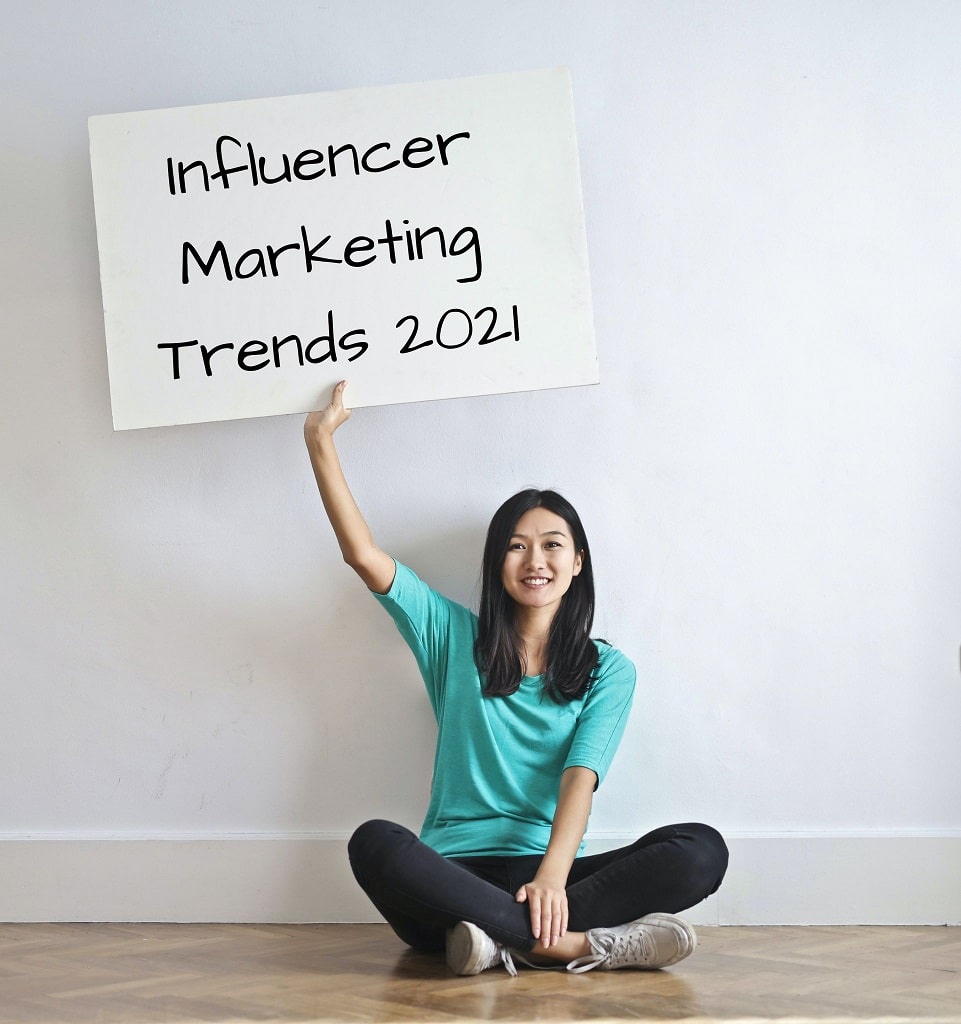13 Influencer Marketing Trends—2021
An article by influencermarketinghub.com.
Recent estimates show influencer marketing set to become a $15 billion dollar industry by 2022, according to Business Insider. It should come as no surprise, then, that 63% of marketers plan to increase their influencer marketing budgets in 2021. As popularity, demand, and marketing spend increase for influencer marketing, it’s important to pay attention to these influencer marketing trends for 2021 so you’re focusing attention and ad dollars on the right things.
1. Micro and Nano Influencers Will Get More Love
There are different types of influencers, from nano influencers with just a few thousand followers to celebrity influencers with millions. According to a 2019 report from Later and Fohr, micro-influencers, particularly those with fewer than 25,000 followers, have the highest engagement rates at around 7%. Considering that engagement rates on Instagram have been declining, influencers with an engaged following are getting a closer look from businesses, even with fewer followers. By focusing on nano and micro-influencers, brands will be able to stretch their influencer marketing budgets while still working with influencers that are deeply connected to their audiences and influencers will benefit from partnerships with an increasing number of brands.
2. Brands Will Look for Ongoing Partnerships Instead of One-Off Projects
Throughout 2021, expect brands and influencers to join together for long-term, ongoing projects rather than one-off sponsored posts. There are multiple reasons for this shift but, ultimately, it comes down to this: it takes time to make a sale. Even influencers with the most engaged audiences are going to have trouble making any real contribution when they’re brought on for a single sponsored post. If you want to capitalize on this influencer marketing trend, we recommend creating packages that you can sell to brands seeking your services that include several sponsored posts over a period of time, much like what they would tend to do when running Facebook ads or ads on other platforms. It can also help to join an influencer marketing network to give yourself some legitimacy.
3. New Social Media Platforms—and Types of Influencer Content—Will Pop Up
If 2020 has taught us anything it’s that we always have room for more social media platforms. TikTok had a stellar year due, in large part, to the pandemic that swept the globe and kept people indoors with little to do. But TikTok isn’t the only new social app to come out of the year. The exclusive, invite-only, audio-based social app Clubhouse and Reels (Instagram’s answer to TikTok) also joined the party in 2020.
When TikTok took off in early 2020, influencers were right there with it, amassing followers on the platform and partnering with brands to create sponsored posts and ads. There’s no doubt that TikTok’s popularity will continue to surge throughout 2021 with both influencers and brands alike. Platforms have also taken lessons from life in a global pandemic to heart, too, making it easier for brands to create and amplify branded content and for consumers to shop on the platforms. Those trends will continue throughout 2021.
In addition to the new social media platforms, we’ll start seeing new and experimental forms of media along with a big push towards AI-driving influencer marketing platforms. CGI influencers have already started to have a moment and as technology continues to advance influencers will come up with even more types of highly-shareable content with the potential for virality.
4. Performance-Based Deals Will Increase
As brands and influencers alike seek out long-term partnerships, it’s likely that performance-based influencer marketing will increase. This means that clients will expect influencers to deliver on their promises such as a specific number of sales or clicks. If you’re an influencer confronted with a performance-based contract, you might want to consider turning it into ongoing royalties instead of accepting a single payment. You’ll also want to be diligent in your contract review before signing to make sure you know what you’re agreeing to before guaranteeing a specific return.
5. Influencers Will Become More Specialized
We’ve already seen influencers carving out niches for themselves and that’s an influencer marketing trend that shows no signs of changing. Influencers will continue to develop expertise in their niche or industry, making them even more sought after by brands in those verticals. As an influencer, it might be time to consider what industries you’re most passionate about and start courting partnerships with brands that make sense for the direction you choose to go. Here’s an example of a specialized influencer (just check out the bio!):
6. Influencer Collaborations Will Increase
Influencer marketing trends indicate that 2021 will bring us more connections and collaborations between influencers. We’ve already seen influencer houses become a thing and it’s highly likely there will be more of that as influencer networks seek ways to increase influencer marketing campaigns and earn more return on their efforts
7. Planning and Data Will Rule
As we mentioned earlier, performance-based contracts and deals are going to increase and that means planning and data will play an important role in influencer marketing for 2021. Now that brands and influencers are more comfortable working together, you’re going to see more collaboration between brands and influencers in planning campaigns and a lot more interest in tracking the social media marketing metrics that let brands know the influencer they’ve found is worth what they’re paying them. While influencer networks already have some analytics and reporting in place, solo influencers are going to need to understand what social media metrics are important so they can deliver on promises.
8. Video Content Will Increase (Even More) In Popularity
Yes, we know. Every year for at least the last seven years, video content has been on everyone’s list of not just influencer marketing trends but marketing trends in general. And there’s a good reason for that. People just love video. With the increasing popularity of TikTok and the introduction of Instagram Reels, we’re going to be seeing more video content than ever. Plus, IGTV is just sitting there, waiting for Instagram to let loose the rain of ad revenue that everyone is expecting once they stop testing and let ads go live on the platform.
The point is, even with platforms like YouTube, Facebook, TikTok, Instagram Reels, IGTV, and many more, consumers are barely getting their itch for video scratched. On Facebook alone, the number of users watching live video increased 50% in early 2020. Sure, there was a global pandemic and lockdowns going on, but a 50% increase is huge
9. Authenticity Will Be the Watchword
For the past few years, there’s been a powerful pull for “authentic” content. This means influencers have to be careful with the content that they create for brands to make sure that the products they take on are going to resonate with their audiences. Of course, this is also something that brands need to watch out for. Even the most engaging influencers aren’t going to be able to whip their followers into a frenzy over a product that they just don’t care about. It won’t benefit the brand trying to make it work and the influencer will likely lose credibility in the eyes of their audience.
Instead, influencers and brands should seek out partnerships only with other influencers and brands whose audiences overlap with theirs. Blatantly sponsored posts themselves aren’t the problem, despite what some social media marketing experts would have you believe. You don’t have to forgo production value or makeup to make your sponsored posts feel more authentic. What makes sponsored content authentic is a genuine sense of excitement about the brand and the product you’re talking about. And this can come across no matter whether or not you’re just sitting in your room or recording on a yacht. Unless you’re doing a sponsored post for a yacht-builder, in which case recording on a yacht would make a lot more sense.
What we tend to lose sight of when talking about the demand for authentic content is what we really want from the content. For most audiences, that means deeper connections with the influencers they follow along with value-driven content. Instead of a standard sponsored post that’s modeled after a TV ad, why not try doing a Q&A about the brand or product you’re sponsoring, or a video that shows what it’s like to use it? You can even talk about the things you don’t love about a brand or product as long as you make sure your followers know that the product, even with its shortcomings, is still the best. The bonus for influencers is that your audience will trust you more. For brands, it’ll show your integrity. And integrity is endearing.
10. Cause and Issue Influencer Marketing Will Continue to Grow
2020 brought us much more in the way of social activism and a lot of influencers and platforms worked to highlight the lack of diversity and equality in influencer marketing. Blackout days became a regular occurrence, drawing attention to how platforms are or are not representing certain populations. Instagram and TikTok, in particular, were brought into the spotlight for being everything from anti-black to anti-fat to anti-sex work. While there are miles to go before any social media platform can truly be lauded for its inclusiveness and celebration of diversity, 2020 finally pushed them in that direction more so than any previous time.
This drive toward diversity and inclusion will have an impact on brands and the way they choose influencers to partner with. But that’s just the start of what’s to come. While we’ll finally start seeing a more diverse selection of influencers, brands will also need to change how they do business as a whole to build diversity and inclusion into every aspect of their brand. More and more, brands will be pressed to take a stand—more than symbolically—on social justice and political topics that they’ve been allowed to shy away from in the past. It should come as no surprise that influencers will get that pressure, too, and will be expected to be more discerning of the brands they partner with.
11. Social Commerce Will Bring New Sponsorship Opportunities
In 2020, brands were forced to get creative with the way they connected with shoppers. Brick-and-mortar stores scrambled to embrace eCommerce and eCommerce stores, suddenly finding themselves with more competitors, had to find ways to offer shoppers better and easier ways to buy. The year basically forced more brands to embrace new technology faster—and forced the creators of new technology to fast-track their inventions.
As such, we’ve seen new opportunities for influencer marketing and brand sponsorships through social commerce. Shoppable videos and shoppable posts have created a seamless user experience from influencer content to brand channels, as well as farther-reaching eCommerce solutions. In 2021, influencer marketers should expect those trends to continue and seek out partnerships with brands that are ready to include shoppable content in their influencer marketing campaigns
12. Employee-Driven Influencer Content Will Increase
An influencer marketing trend for 2021 that stems from the demand for more authentic content is that the desire to see employee-driven or employee-based content will increase. We’ve already seen how user-generated content can have a huge impact on sales and how brands are perceived; it only makes sense for brands to begin treating their own employees as influencers through employee advocacy programs.
We’ve already seen how this works for brands like Macy’s. With its Style Crew, Macy’s offers incentives and financial rewards to employees who use Macy’s products in their everyday lives if sharing that content leads to sales. This works for Macy’s employees and the company itself because consumers are fascinated by seeing “how the sausage gets made.” There’s a reason why the video of a Wendy’s employee making a Baconator got more than 3 million views after Wendy’s reposted it. People want to know what goes on behind the scenes at a company. Giving employees the go-ahead to share that content just makes sense.
13. Paid Advertising Will Be Key for Broad Reach
The last of the influencer marketing trends on our list for 2021 is all about advertising. Yes, we realize that paid ads are typically not used in conjunction with influencer marketing campaigns. However, brands and influencers will both benefit from the paid amplification of the content created by influencers. Using the fine-tuned targeting available on Facebook Ads or through the advertising tools for other social media platforms, brands will be able to push out high-quality influencer content to the people who care about seeing it, without relying on social media algorithms to make it happen.


